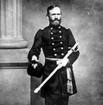Justice John Marshall Harlan
 __ __ ___ _ _ _ ___ _____ _____ _____________
__ __ ___ _ _ _ ___ _____ _____ _____________
John Harlan was a southern Whig who fought for the North during the Civil War and freed his slaves before its end. He was once part of the anti-immigrant, anti-Catholic Know-Nothing Party, and opposed Lincoln's re-election and the Thirteenth Amendment. The former slave owner changed his political views with the election of Ulysses S. Grant, especially his desire to protect the rights of the freedmen. He was sent to Louisiana in 1877 by President Hayes as a special commissioner investigating the 1876 state election. Hayes then appointed Harlan to the court in 1877. Justice Harlan dissented in 1883 with the Civil Rights Cases, and was the lone dissenter in the Plessy decision; he thus became known as the "Great Dissenter" (1).
Judge Harlan's dissent
In respect of civil rights, common to all citizens, the Constitution of the United States does not, I think permit any public authority to know the race of those entitled to be protected in the enjoyment of such rights. Every true man has pride of race, and under appropriate circumstances which the rights of others, his equals before the law, are not to be affected, it is his privilege to express such pride and to take such action based upon it as to him seems proper. But I deny that any legislative body or judicial tribunal may have regard to the race of citizens which the civil rights of those citizens are involved. Indeed, such legislation as that here in question is inconsistent not only with that equality of rights which pertains to citizenship, national and state but with the personal liberty enjoyed by everyone within the United States....
It was said in argument that the statute of Louisiana does not discriminate against either race but prescribes a rule applicable alike to white and colored citizens. But this argument does not meet the difficulty. Everyone knows that the statues in question had its origin in the purpose, not so much to exclude white persons from railroad cars occupied by blacks, as to exclude colored people from coaches occupied by or assigned to white persons. Railroad corporations of Louisiana did not make discrimination among whites in the matter of accommodation for travellers. The thing to accomplish was, under the guise of giving equal accommodations for whites and blacks, to compel the latter to keep to themselves while travelling in railroad passenger coaches. No one would be so wanting in candor as to assert the contrary. The fundamental objection, therefore, to the statues is that it interferes with the personal freedom of citizens....If a white man and a black man choose to occupy the same public conveyance on a public highway, it is their right to do so, and no government, proceeding alone on grounds of race, can prevent it without infringing the personal liberty of each....
The white race deems itself to be the dominant race in this country. And so it is, in prestige, in achievements, in education, in wealth, and in power. So, I doubt not, it will continue to be for all time, if it remains true to its great heritage and holds fast to the principles of constitutional liberty. But in the view of the Constitution, in the eye of the law, there is in this country no superior, dominant, ruling class of citizens. There is no caste here. Our Constitution in color-blind and neither knows nor tolerates classes among citizens. In respect of civil rights, all citizens are equal before the law. The humblest is the peer of the most powerful. The law regards man as man and takes no account of his surroundings or of his color when his civil rights as guaranteed by the supreme law of the land are involved.... (2).
FOOTNOTES
1. Brook Thomas, ed., Plessy v. Ferguson: A Brief History with Documents (Boston: Bedford/ St. Martins, 1997), 182.
2. McKenna, George, ed. A Guide to the Constitution That Delicate Balance (New York, 1984), pp. 384-386. (accessed from<http://chnm.gmu.edu/courses /nclc375/harlan/html> on December 1, 2009).
